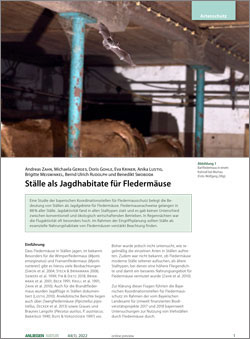Ställe als Jagdhabitate für Fledermäuse
Andreas Zahn, Michaela Gerges, Doris Gohle, Eva Kriner, Anika Lustig, Brigitte Meiswinkel, Bernd Ulrich Rudolph und Benedikt Swoboda
Ställe als Jagdhabitate für Fledermäuse
Eine Studie der bayerischen Koordinationsstellen für Fledermausschutz belegt die Bedeutung von Ställen als Jagdgebiete für Fledermäuse. Fledermausnachweise gelangen in 88 % aller Ställe. Jagdaktivität fand in allen Stalltypen statt und es gab keinen Unterschied zwischen konventionell und ökologisch wirtschaftenden Betrieben. In Regennächten war die Flugaktivität oft besonders hoch. Im Rahmen der Eingriffsplanung sollten Ställe als essenzielle Nahrungshabitate von Fledermäusen verstärkt Beachtung finden.
Summary
Stables as foraging habitats of bats
We studied bat activity by the use of automatic sound recording systems (batcorder, ecoObs GmbH) in 110 stables distributed over all seven districts of Bavaria between May and September 2017 and 2018. We sampled each stable during two consecutive nights. Most stables were located at cattle and dairy farms. In six cases horses were kept. In 18 stables, mist netting was conducted in addition to acoustic monitoring.
Bats were recorded in 88 % of all stables. The most common species were Pipistrellus pipistrellus (species-specific calls were recorded in 71 % of all stables with bats), Myotis brandtii/mystacinus (60 %; both species were verified by mist netting), Myotis nattereri (52 %) and Myotis emarginatus (24 %). Activity of these species was in many cases recorded over several hours.
Rarely recorded species were Rhinolophus ferrumequinum (one stable), Barbastella barbastellus, (two stables), Pipistrellus nathusii (6 stables) and Pipistrellus pygmaeus (8 stables). While species identification based on sound recordings alone is challenging for the genus Plecotus (sound recordings in 4 stables), activity of Plecotus auritus could be verified by mist netting. On a few occasions, sound recordings provided additional evidence for the presence of Myotis bechsteinii, Myotis myotis, Myotis daubentonii, and Eptesicus nilsonii.
Bats foraged in old “traditional” stables as well as in modern ones and there was no significant difference in bat activity between organic and conventional farms. During rainy nights, overall bat activity inside stables was higher than during nights without rain. While P. pipistrellus was found more often in higher and larger “modern” stables, M. emarginatus and M. nattereri tended to use lower stables. Horse stables were less frequented than stables for cattle. We recorded final buzzes of Myotis and Pipistrellus species documenting active hunting behavior inside stables. While foraging activity of gleaning Myotis species in stables was already reported several times, the intensive flight activity of Pipistrellus pipistrellus was a surprising result of the study. We still do not know which insects Pipistrelles prey on in stables and which foraging strategies are used.
However, stables proved to be important foraging sites for several species of bats in Bavaria and bat colonies in the surroundings of farms might profit a lot. The ongoing decline in cattle farm numbers may aggravate the depletion of insects as food sources for bats in many landscapes.
Zum Volltext-Download:
ANLiegen Natur 44/1 (2022): 8 Seiten als Volltext herunterladen (pdf barrierefrei 1,1 MB).

 | 0
| 0 
